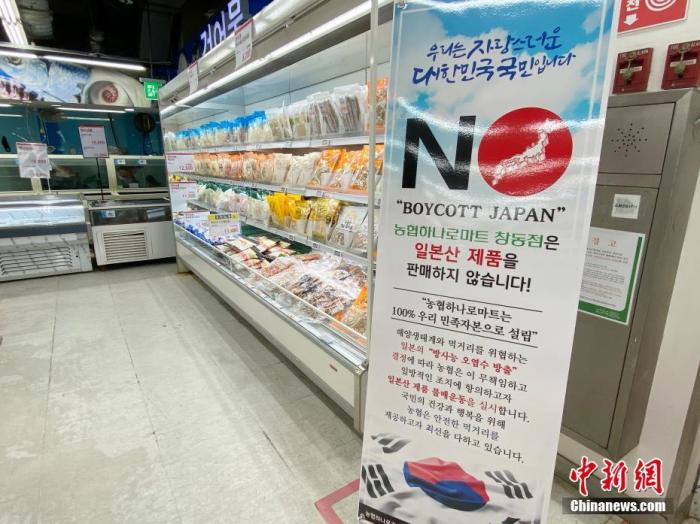China News Service, December 4th. According to Korean media reports, the South Korean government and the Japanese government held a video-linked working meeting on the 3rd to discuss the draft of Tokyo Electric Power’s "Radiation Impact Assessment Report on Fukushima Nuclear Sewage Discharge to the Sea" (Part 2) Called the "report") for discussion.
The South Korean side expressed deep regret at the meeting that Japan released the report on the premise of discharging nuclear sewage into the sea.
Data map: On April 15, slogans such as "Boycott Japanese goods" were hung up in a seafood sales area of a large supermarket in Seoul.
In response to Japan's decision to discharge nuclear contaminated water from the Fukushima Daiichi Nuclear Power Plant into the sea, all walks of life in South Korea expressed protests and doubts.
Photo by China News Agency reporter Zeng Nai
According to reports, Tokyo Electric Power released a report on November 17 that confirmed through research that the Fukushima nuclear sewage discharge has little impact on human health and the environment.
According to the results of the study on the concentration and diffusion of tritium at a distance of 10 kilometers from the Fukushima Daiichi Nuclear Power Station, the area where the tritium concentration rises due to the discharge of nuclear sewage is limited to 2-3 kilometers from the Fukushima Daiichi Nuclear Power Plant.
The South Korean government expressed its regret at the meeting that Japan released the report on the premise of discharging nuclear waste water into the sea, and expressed its deep concern again about the impact of nuclear waste water discharge on humans and the environment.
The government questioned the main assumptions and research methods involved in the report, and requested the Japanese side to provide additional information.
It is reported that Tokyo Electric Power has filtered the nuclides in Fukushima nuclear sewage through the Multi-Nuclide Treatment System (ALPS), but failed to remove the radioactive substance tritium.
Prior to this, the Korea Atomic Energy Safety Commission had expressed regret that Japan’s Tokyo Electric Power Company issued a radiation impact assessment report for the Fukushima nuclear sewage discharge plan.
The committee stated that the report presupposes the discharge of nuclear sewage to the sea, but it does not fully explain the inevitability of the sea discharge plan.
On March 11, 2011, a massive earthquake occurred in the waters near Fukushima Prefecture, Japan.
Affected by this, the cores of units 1 to 3 of the Fukushima Daiichi Nuclear Power Plant melted down, and Tepco continued to inject water into the containment of units 1 to 3 to cool the core and recover sewage.
On April 13, 2021, the Japanese government officially decided to filter and dilute the Fukushima nuclear sewage into the sea. The discharge time is expected to last 20 to 30 years. However, this decision was met by residents of Fukushima Prefecture and the National Fisheries Union of Japan. Strong opposition from the Federation and others.

